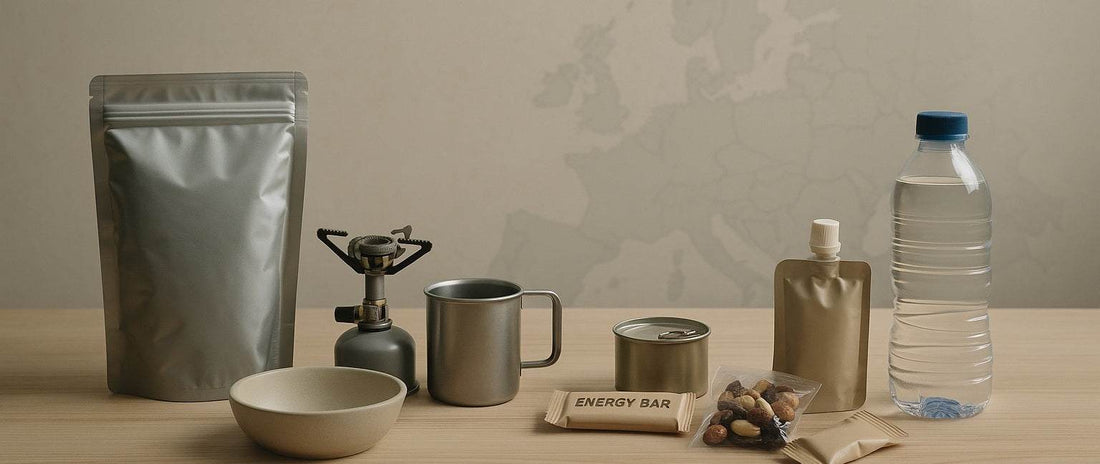
Why You Should Avoid Freeze-Dried Food in a 72-Hour Survival Kit
Share
When building a 72-hour emergency kit, many people instinctively reach for freeze-dried meals. Lightweight, long shelf-life, easy to store—what could go wrong? Quite a lot, actually. While freeze-dried food can be useful in some scenarios, it is far from ideal for short-term survival situations, especially during the first 72 hours of a crisis.
Here’s why you should think twice before packing freeze-dried food into your emergency kit—and what smarter alternatives look like.
1. Freeze-Dried Food Requires Boiling Water
One of the biggest disadvantages of freeze-dried food is that it needs hot water to become edible. In a survival situation, especially in an urban environment, access to clean water and the ability to boil it is not guaranteed. Power might be out, gas may be shut off, and time is limited.
Boiling water also consumes fuel—something precious during a crisis. Every meal becomes a logistical challenge: Where do you boil the water? How long do you wait? What if you’re on the move?
In contrast, ready-to-eat food doesn’t need preparation. You open, you eat, you move on.
2. Dehydration Risk in High-Stress Situations
Freeze-dried meals absorb a lot of water—not just during rehydration, but also in your body. In a crisis, staying hydrated is essential for clear thinking and physical performance. Meals that pull water from your system can make you feel sluggish, increase fatigue, and worsen dehydration.
In short: freeze-dried food is water-intensive. But water is a precious resource you might not have in abundance.
3. Not Built for Urban or Fast-Paced Emergencies
Freeze-dried food is often marketed for wilderness expeditions or long-term storage. But the first 72 hours of a crisis—especially in a city—are fast, chaotic, and unpredictable. You need food that is:
- Grab-and-go
- Shelf-stable without preparation
- Safe to eat cold
- Easy to share or ration
Freeze-dried food requires stopping, unpacking, boiling, waiting—luxuries you might not have. Emergency food should keep you mobile, alert, and efficient.
4. Taste Fatigue and Digestive Stress
Let’s be honest: most freeze-dried meals aren’t gourmet. During a high-stress event, your body is already under strain. Eating highly processed, low-fiber, overly salty food can cause digestive discomfort, bloating, or even nausea—especially if you're not used to it.
In comparison, compact and varied ready-to-eat items (nuts, energy bars, canned fish, crackers, dark chocolate) are easier on the stomach and often more enjoyable.
5. Poor Fit for Family and Vulnerable Populations
If your emergency kit is meant to serve children, elderly people, or those with specific health conditions, freeze-dried food can be a liability. Not everyone can chew or digest them easily. And in a stressful situation, having to manage cooking for a family with special needs becomes a major burden.
Better to carry food everyone can eat immediately, even in the dark, even while walking, even while scared.
What to Pack Instead of Freeze-Dried Meals
The best 72-hour survival kits are stocked with ready-to-eat, no-prep food items that provide calories, energy, and morale. Examples include:
- Vacuum-packed cooked rice and lentils
- High-calorie energy bars or protein bars
- Canned fish or meat with pull-tabs (tuna, sardines, chicken)
- Mixed nuts and dried fruit (trail mix)
- Crackers or hardtack
- Peanut butter in single-serve packs
- Dark chocolate for quick energy and morale
All of these options are shelf-stable, don’t require heating, and can be eaten on the move. Combined with a solid water supply (and purification if needed), these items give you what you need to stay sharp and resilient.
Conclusion: Convenience Over Complexity
When the first 72 hours matter most, simplicity is survival. Freeze-dried food might seem efficient on paper, but in practice, it complicates your response, consumes resources, and creates unnecessary risks.
Build your survival kit with food that works in real-world emergencies—not just in theory. Choose nutrition that’s fast, reliable, and ready when you are.
Need help building the perfect emergency kit?
Explore our customizable 72-hour survival kits designed for real people, real cities, and real crises.


